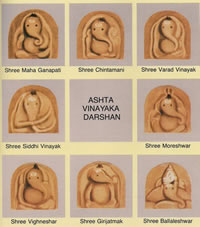GANAPATYAM
The worship of Ganapati (Ganapatyam) as a remover of all impediments, is one of the six forms of worships(Shanmatha) established by Adi Sankara.
Ganapati is the primordial deity in Ganapatyam. Temples dedicated to Ganpati according to Vastu texts, should find a separate place in the village layout, be it a Saivaite settlement or a Vaishnavite one. Ganesa also appears as a Parivara Devata in the temples of Siva or Vishnu. In the latter, he goes by the name Tumbikkai Alwar. Ganapati is also the primordial scribe, dedicated to writing the entire Mahabharata-at the dictate of sage Vyasa. Ganapati images are portrayed either standing, seated, or dancing. (Nrittya Ganapati). |
Vatapi 'Ganapati is a popular deity in Tamil Nadu. Most of the carnatic musical conerts begin with the song Vatapi Ganaptim Bhaje. Ganapati is essentially conceived mostly as a Brahmachari, but also with his consorts Siddhi-Buddhi, or Vallabh. There are various forms of Ganapati. Among the Upanishads, the one named Ganapati Upanishads extols the greatness of the Ganapati Cult. The worship of Ganapati is not only popular among the Hindus, but also among Buddhists. Ganapati worship is popular in far eastern countries like Indochina, Cambodia, Japan and other adjacent countries.
Ganapati Pooja is a precondition for the performance of any religious function or rite, individualistic or congregational. Pooja for Vinayak is called Vishvaksena Aradhanam, among Vaishnavites.
Volumes can be written about Ganesh's birth, how he came to have the elephant hand, why he holds a broken tusk in his hand, his powers of blessings. He is the personification of OM, the Pranavamanthra. Whatever may be the origin of the elephant head, the elephant is ever attractive and pleasing to children and elders. The pot bellied, elephant headed Ganesha has a rat for his vehicle and is the benevolent deity of the Hindu Pantheon.
In the South Indian villages there are many temples exclusively for the worship for Vinayaka but there is no village where he does not exist. You can see him on the river banks, under a banyan tree, without a temple, without a canopy-people worship the riverside Ganapathis-the first thing after their bath. |


